QuestionWell sadly, the silver molly died shortly after I e-mailed you, but the black molly seems to be going strong. He always seemed more lively than the silver one.
In answer to your questions, the tank is 2.5 gallons and the fish were about 2 inches each. I'm not exactly sure of the water temperature but it seems fairly warm, but not too hot. There is a lightbulb above that warms it up a bit. I do have a filter and I did not add any salt..although if you think this is a good idea then I could do this.
Also, since the silver molly died do I need to change the water or will the black molly be alright. I did notice the cloudiness for the first few days but now its all cleared up and looks really clean.
-------------------------
Followup To
Question -
I bought a silver molly and a black molly about a week ago. I had set up the tank a few days before and have kept the water very clean as well as fed them regularly. The black on seems fine, but suddently the white one has been acting very strangely. Today I came home and it had its body wedged down into a plant with its back fin down towards the gravel and its head sticking straight up towards the surface. What's going on?
Answer -
Hi Kelly;
I think the fish is experiencing the effects of new tank syndrome. Some fish are affected more seriously than others. I will include an article about it at the end of this letter. In the meantime, make a 25% water change to help them both and if I could get a bit more info from you;
What size tank is it?
How big are the fish?
What is the water temperature?
Does it have a filter?
Did you add any aquarium salt for them? If so, how much?
Let me know as soon as you can....
**********
New Tank Syndrome or Break-in Period
So you have a new tank and you filled it up, put the filter together, mounted the heater into place and turned on the lights. You have all the plants and decorations where you want them....
You are ready for fish.
But, your filter is not ready for a full tank of fish yet.
The filter is running and moving the water and cleaning out crud, right? Of course!
But a very important part of your filter is the part you can't see. An aquarium filter removes the larger visible stuff, but it also must remove the dissolved fish waste that turns into ammonia in the water. To do this, special bacteria must grow in the filter system and on the particles of gravel in the bottom of your tank. This process occurs even on a limited scale in little fish bowls that have no filter in them.
This is "New-Tank Syndrome" or the "Break-in Period". The entire process takes 6 to 8 weeks to complete because these "nitrifying" bacteria grow quite slowly.
Start off with only one or two hardy fish (no more than 2 total inches of fish) for every ten gallons of water and don't add more until the 6 to 8 weeks has gone by. Hard to be patient, but it is worth it to keep your fish alive and healthy. As a matter of fact, the bacteria cannot develop without fish in the tank. You can let that tank sit forever without fish in it, but as soon as the first fish goes in the process begins. Avoid changing the filter pads during break-in. This removes the bacterial colonies that are essential to a balanced aquarium. You can rinse the filter pad out in a container of aquarium water. This will preserve most of the bacteria colonies while still allowing your filter to flow freely. Even using bacteria additives and water conditioners when you first set up the tank will not make a tank begin the cycle by itself. If there are no fish to provide food (fish waste) for the bacteria, the beneficial bacteria cultures will die and you will have to start the colonies all over again once fish are added to the tank. Once the tank has completed the initial cycle, you can change the filter pads every 4 weeks or so. But for now, just rinse them.
Feed your new fish VERY lightly. Any excess food will cause additional waste your system cannot afford to have right now. If you see food floating around or lying on the plants and gravel after five minutes, too much food is going into the tank. Cut back a little each time you feed until it is ALL gone 5 minutes after you feed them. Feed them once a day.
During this "break-in period" your tank will become cloudy and milky looking. You may have to tolerate this for the entire break-in period but it is only temporary. Changing 25% of the water three times a week until the break-in period is over helps a great deal. Changing water reduces the ammonia and nitrites that rise while the bacteria continues to multiply. If ammonia and/or nitrites become too high, your fish will become stressed and possibly die. Use a good water conditioner when you replace the water and make sure it is the right temperature to avoid shocking your fish.
When the break-in is over after 6 to 8 weeks and there are no nitrites or ammonia present in the water you can slowly add more fish. Add one or two every week until you reach the desired population. This allows the bacteria to adjust to the new population every time before adding more. Monitor the nitrites and ammonia to be sure they don't come up. If they do, make a 25% water change and check them again. Don't add the next fish until the levels are down again.
The safe maximum population for any size tank is one inch of adult fish for every gallon of water in the tank. Do some research to be sure of the fish you are interested in. Even though they are small when you buy them, you have to base your population calculations on full-sized adult fish. Many hobbyists have up to two inches per gallon but this can be risky. If a water quality issue arises or a disease occurs it will spread fast and furious in an over-populated tank. In any case, 25% water changes every week to two weeks are absolutely essential for the health of your fish.
Following these guidelines will help you get your new tank on the right track.
**********
Followups Welcome
At Your Service;
Chris Robbins
AnswerHi Kelly;
Oh, that's too bad you lost him. So sorry to hear that. Tank size and New Tank Syndrome are definitely the problem. If you read my article you now know that this many inches of fish in a new tank is not a good idea. Actually, two fish of that size in a 2.5 gallon is too much even if the tank were fully finished breaking in. Make a 25% water change today and another one every day for the next 4 days. This will get the toxins down to a level that the fish can tolerate without stressing it too much. You don't want to clean it all out though. This would cause the break-in to start over again and you will be waiting even longer for it to fully finish. This will put the fish in more danger.
Mollies are tropical and need a heater to survive. The water temperature needs to remain a constant temperature of 75 to 78. Without a heater the temperature will fluctuate and cause stress leading to illness and death. The trouble is a tank that small cannot have a heater safely. Heaters are made for tanks 5 gallons and up. All in all, I really think you would be better off with a different kind of fish. Maybe danios, white clouds, or a pair of guppies. I really recommend you not get the often suggested goldfish or a betta though. Contrary to common belief goldfish get way too big for a tank that size (6 to 8 inches) and bettas are tropical like the mollies. It would mean more dead fish and heartbreak for you I'm afraid. :-(
At Your Service;
Chris Robbins

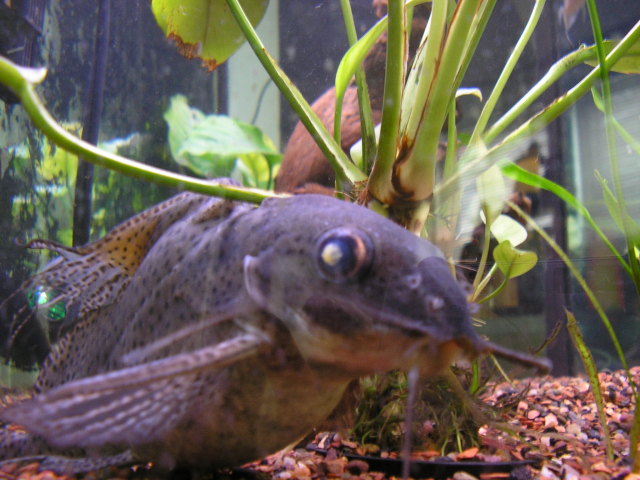 eye problem in black lace cat fish
QuestionQUESTION: This fish has what looks like yellowi
eye problem in black lace cat fish
QuestionQUESTION: This fish has what looks like yellowi
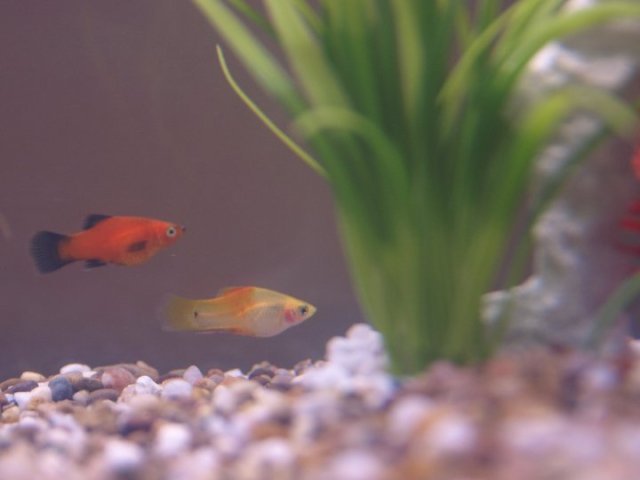 Pregnant platy? Red gills & medicine
Question
red platy
Hi there, I havent been keeping fish
Pregnant platy? Red gills & medicine
Question
red platy
Hi there, I havent been keeping fish
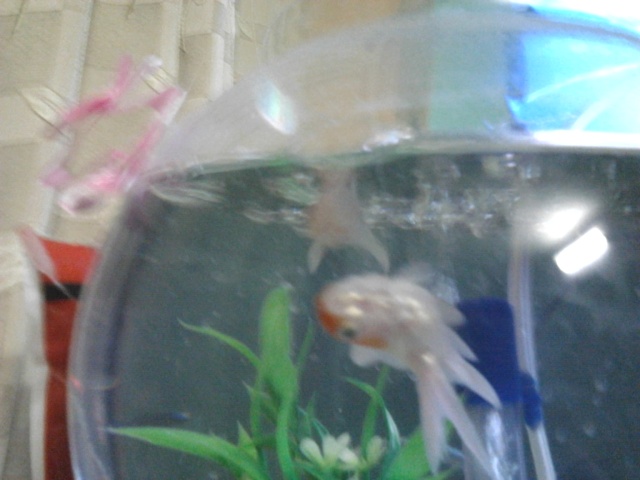 red cap oranda sick
Question
big fish (upside down)
i have 2 red cap oranda
red cap oranda sick
Question
big fish (upside down)
i have 2 red cap oranda
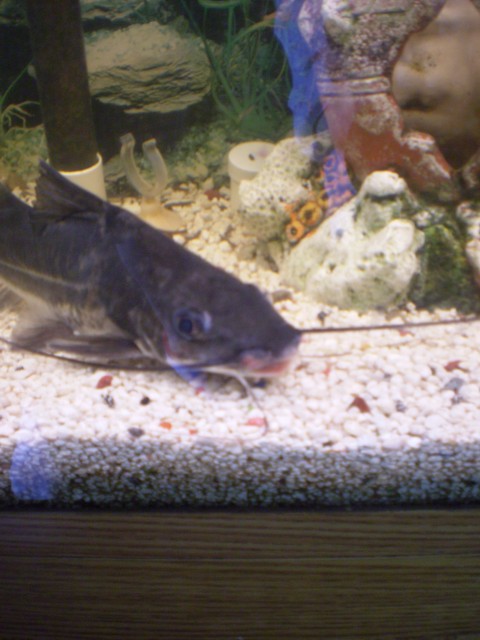 feeler rot / air gulping
QuestionRamona
QUESTION: Hi, I submitted this sa
feeler rot / air gulping
QuestionRamona
QUESTION: Hi, I submitted this sa
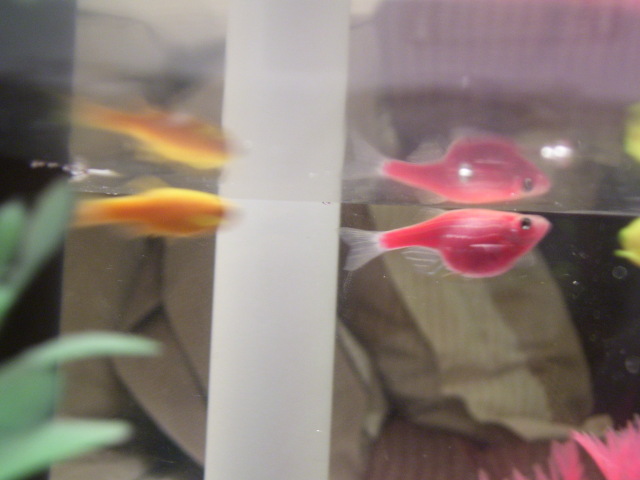 Zebra Danios (GloFish)
Question
Picture
I have several pet glofish (http://www
Zebra Danios (GloFish)
Question
Picture
I have several pet glofish (http://www